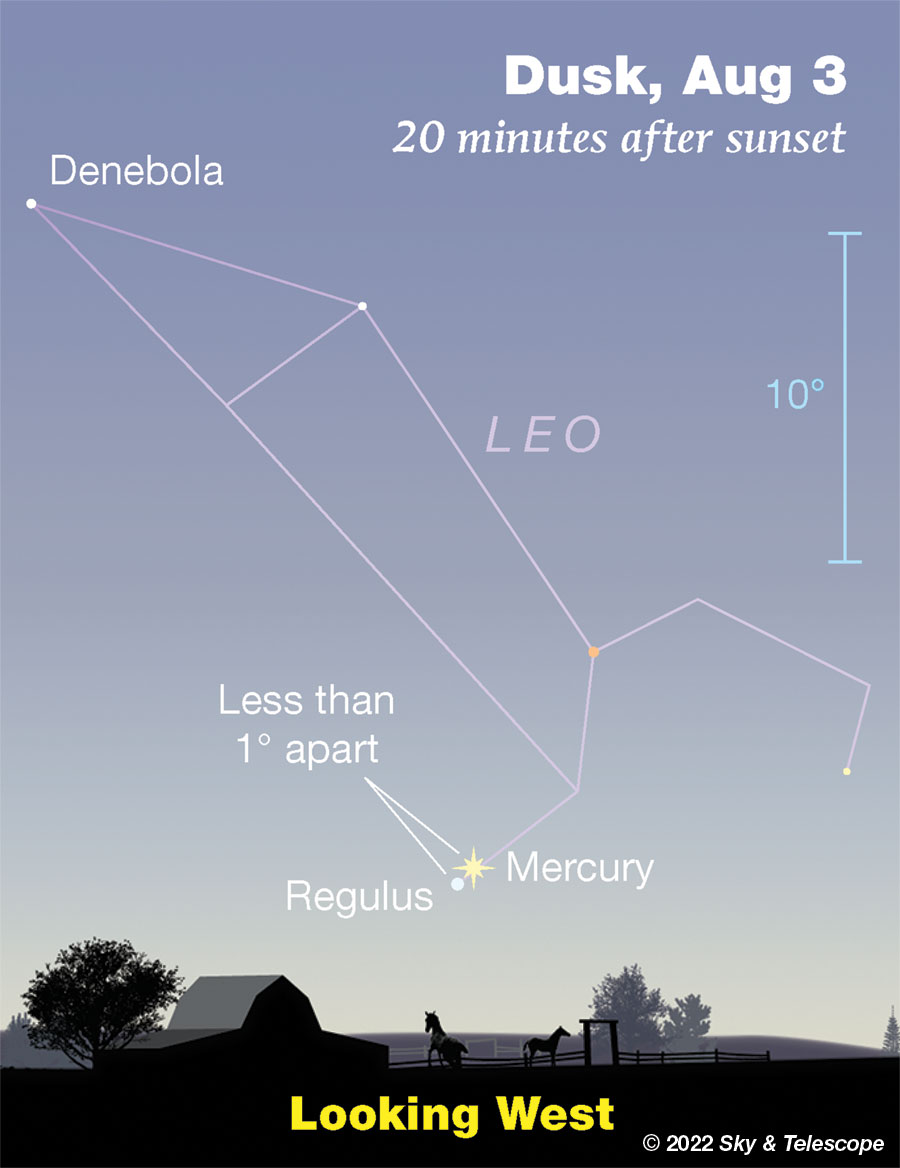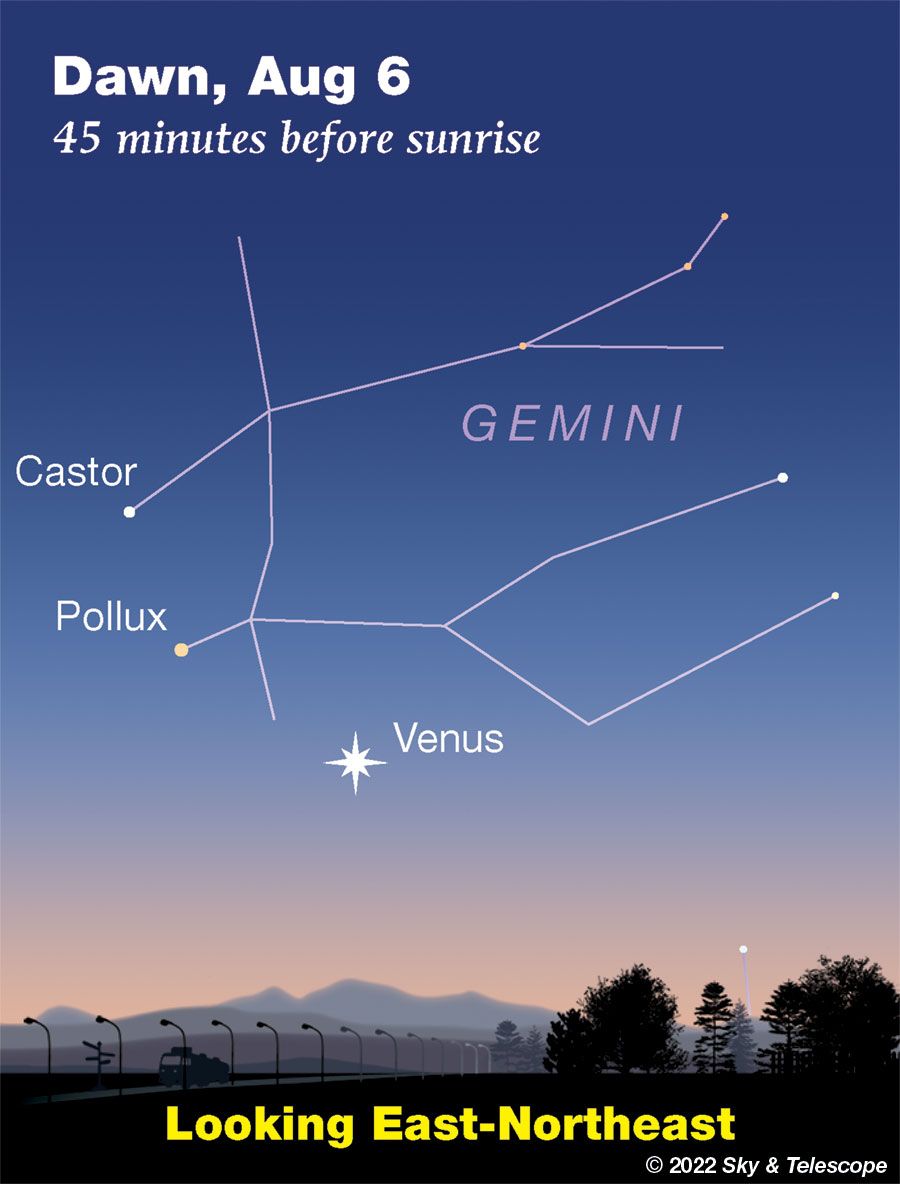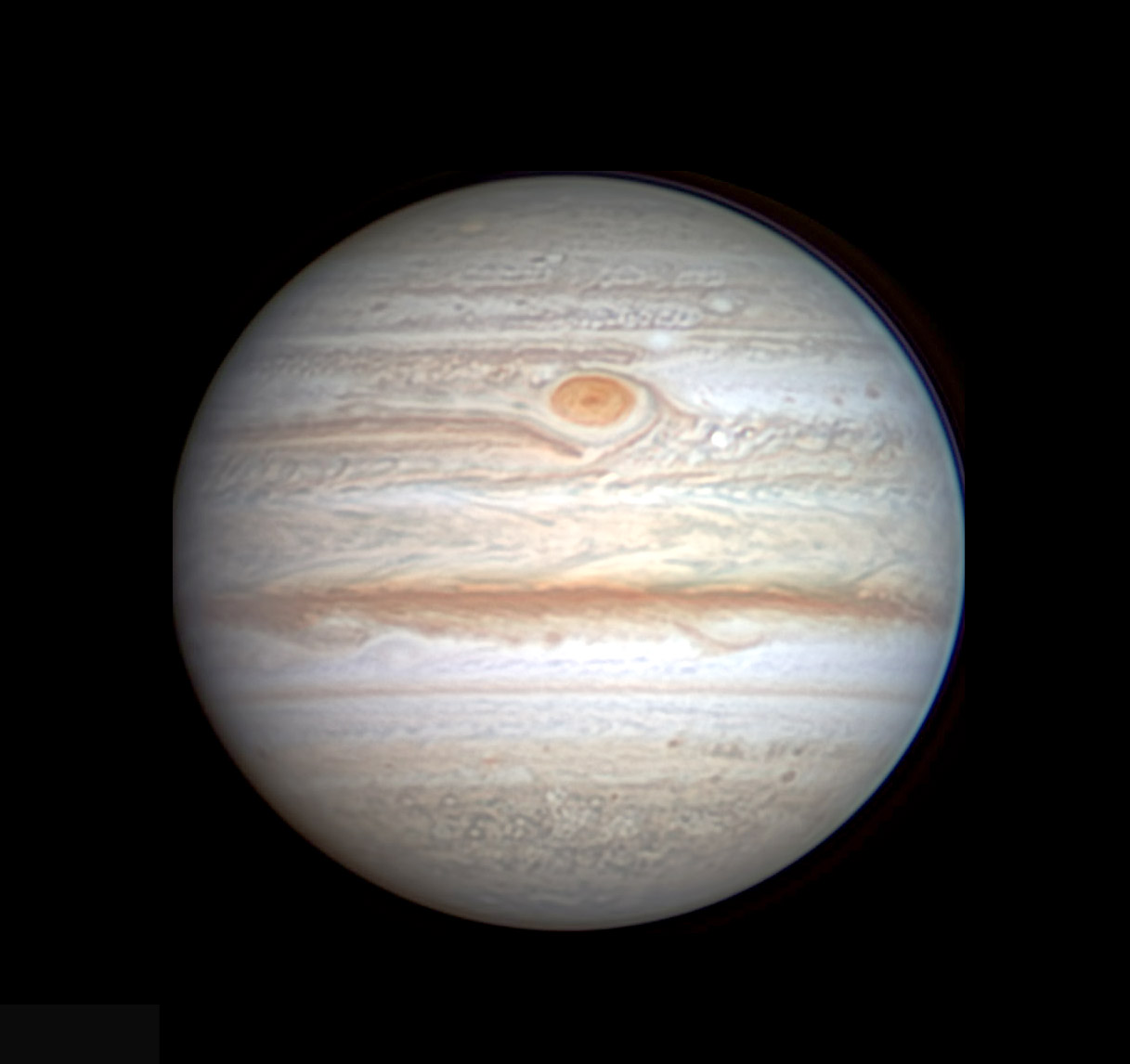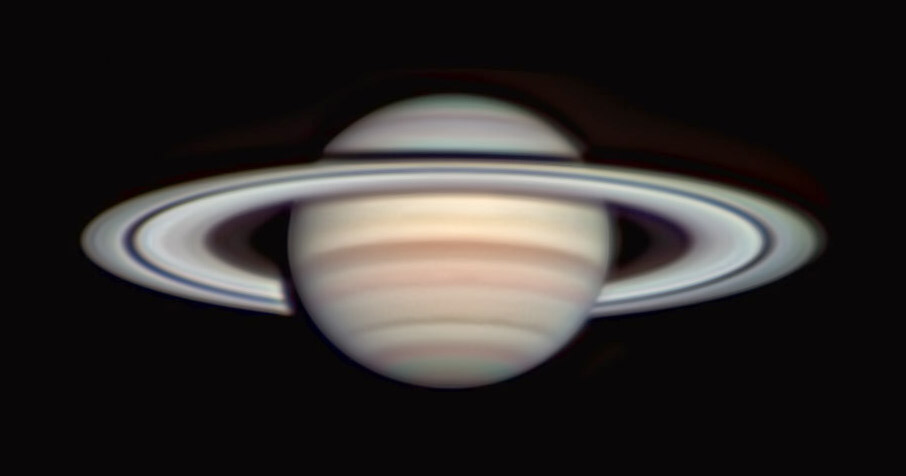FRIDAY, JULY 29
■ The Big Dipper hangs diagonally in the northwest after dark. From its midpoint, look to the right by about three fists at arm's length to find Polaris (not very bright) glimmering due north as always.
Polaris is the end of the Little Dipper's handle. The only other Little Dipper stars that are even moderately bright are the two forming the outer end of its own bowl: 2nd-magnitude Kochab and 3rd-magnitude Pherkad. Find them to Polaris's upper left, by about a fist and a half at arm's length, one over the other. They're called the Guardians of the Pole, since they ceaselessly circle around Polaris through the night and through the year.
SATURDAY, JULY 30
■ Face southeast after darkness is complete. Look a little more than halfway from horizontal to overhead, and there's Altair, the brightest star in that immediate area.
A finger-width above it is its little sidekick identifier Tarazed (Gamma Aquilae), two magnitudes fainter and far in the background. Tarazed is actually 100 times more luminous than Altair — it's an orange giant — but it's 390 light-years away compared to Altair's distance of just 17 light-years.
■ Look left of Altair by a bit more than a fist for compact little Delphinus, the Dolphin, leaping leftward in the edge of the Milky Way.
Closer to Altair's upper left is Sagitta the narrow Arrow, smaller and dimmer than Delphinus. The arrow points left. Binoculars help with both.
SUNDAY, JULY 31
■ The False Comet. Lower Scorpius is on the meridian right after dark, offering us northerners our best view of this rich region. A favorite binoculars sight here is the False Comet, a curving spray of stars extending almost 2° up from Zeta Scorpii. In photos, an emission nebula adds to the scene.
To find Zeta Sco: From bright Antares, follow the constellation pattern of the Scorpion lower left and downward by four stars to where the pattern jogs left. That's Zeta. In the August Sky & Telescope Matt Wedel writes, "To the naked eye [in a dark sky] the stars and clusters can look remarkably like a comet, but binoculars of any magnification will explode that illusion into a wonderland of suns." See his Binocular Highlight column on page 43 of that issue, with chart.
MONDAY, AUGUST 1
■ Three doubles at the top of Scorpius. Meanwhile, much higher at the other end of Scorpius — atop the vertical row of three stars to the right of Antares — stands Beta Scorpii or Graffias: a fine double star for telescopes, separation 13 arcseconds, magnitudes 2.8 and 5.0.
Just 1° lower left of Beta is the very wide naked-eye pair Omega1 and Omega2 Scorpii. They point roughly back to Beta. The two Omegas are 4th magnitude and ¼° apart. Binoculars show their slight color difference; they're spectral types B9 and G2.
Upper left of Beta by 1.6° is Nu Scorpii, separation 41 arcseconds, magnitudes 3.8 and 6.5. In fact it's a telescopic triple. High power in good seeing reveals Nu's brighter component itself to be a close binary, separation 2 arcseconds, magnitudes 4.0 and 5.3, aligned almost north-south.
■ We're hardly halfway through summer, but already Cassiopeia is getting well up after dark. Look for its tilted W pattern in the north-northeast.
High above Cas is dimmer Cepheus. Below it, the head of Perseus is poking up. The farther north you live the higher they will appear.
■ And when is the exact midpoint point of summer? Halfway from the June solstice to the September equinox. This year it works out to be at 1:09 a.m. August 7th Eastern Daylight Time (5:09 August 7th UT). That minute is the exact center-balance of astronomical summer: the very top of the circle of the year as defined by the astronomical seasons.
For the Northern Hemisphere, that is. It's the exact bottom of winter for the Southern Hemisphere.
TUESDAY, AUGUST 2
■ Arcturus dominates the high western sky after dark. Spot the Big Dipper off to its right, in the northwest.
In astronomy lore today, Arcturus may be best known for its cosmic history: It's a Population II orange giant some 7 billion years old, older than the solar system, racing by our part of space on a trajectory that indicates it came from another galaxy: a dwarf galaxy that fell into the Milky Way and merged with it.
But in the astronomy books of our grandparents, Arcturus had a different claim to fame: It turned on the lights of the 1933 World's Fair in Chicago, celebrating "a century of progress." Astronomers rigged the newly invented photocell to the eye end of big telescopes around the US and aimed the scopes where Arcturus would pass at the correct moment on opening night. In places where the sky was clear the star's light crept onto the photocells, the weak signals were amplified and sent over telegraph wires to Chicago, a switch was tripped, and on blazed the massive lights to the cheers of tens of thousands.
Why Arcturus? Astronomers of the time thought its was 40 light-years away (modern value: 36.7 ±0.2 light-years). So the light would have been in flight since the previous such great event in Chicago, the World's Columbian Exhibition in 1893.
And earlier? Arcturus was known as the first of the nighttime stars to be seen in the daytime with a telescope: by Jean-Baptiste Morin in 1635.
WEDNESDAY, AUGUST 3
■ Mercury is very low in the west in bright twilight this week. This evening you can use binoculars, or better a telescope, to seek both Mercury and fainter Regulus close by it. You'll have only a narrow time window, if any, between the sky being too bright and the elusive pair being too low. Good luck.

■ The thick crescent Moon shines in the southwest at nightfall. Look below it, by about 3°, for Spica.
■ You probably know that the Big Dipper's curved handle "arcs to Arcturus." But the arc of the handle itself, extended to include the adjacent side of the Dipper's bowl, guides the way to another landmark. Fairly near the focus of that longer arc (the center of the circle that the arc would be part of) is 3rd-magnitude Cor Caroli, Alpha Canum Venaticorum. This is a lovely double star for small telescopes: colors white and pale yellow-white, separation a generous 23 arcseconds.
THURSDAY, AUGUST 4
■ The Moon is nearly first quarter. More than a fist to its lower right at the end of dusk, look for Spica getting low. Closer in the opposite direction from the Moon is Alpha Librae, a wide binocular double star. Its components are currently almost horizontal. The fainter one (magnitude 5.1) is to the right of the brighter one (mag 2.8), by a chasm of 281 arcseconds.
FRIDAY, AUGUST 5
■ First-quarter Moon (exact at 7:07 a.m. on this date EDT). After dark the Moon shines in central Libra. Delta Scorpii and then brighter Antares are to its left, Spica is farther to its lower right, and Arcturus shines even farther to the Moon's upper right.

SATURDAY, AUGUST 6
■ Now the Moon shines in the head of Scorpius. Look for orange Antares just to its left and Delta Scorpii just to its right (during evening for the longitudes of the Americas).
This Week's Planet Roundup
Mercury is very low in the glow of sunset. About 30 minutes after sunset, try scanning for it with binoculars just above the horizon a little to the right of due west (one or two fists at arm's length). Good luck. At least Mercury is pretty bright: roughly magnitude –0.5 all week.
Venus, magnitude –3.9 in Gemini, continues to rise just as dawn begins. As dawn brightens, look for it low in the east-northeast. It's far below Capella.
Mars, magnitude +0.2 in Aries, rises around midnight or 1 a.m. and shines high in the east-southeast as dawn begins. It rises about four fists lower left of bright Jupiter. By dawn they're high in the south, with Mars now directly left of Jupiter.
Mars is still small in a telescope, 8 arcseconds in apparent diameter.
Jupiter rises due east around 10 or 11 p.m, shining at a bright magnitude –2.7 at the Pisces-Cetus border. It's highest in the south (transiting) as dawn begins. In a telescope Jupiter is now a good 45 arcseconds wide.

Saturn, magnitude +0.4 in western Capricornus, is nearing its August 13-14 opposition. It's very low in the east-southeast in late twilight, higher in the southeast in late evening, and at its highest and best in the south around 1 a.m. Saturn's rings appear roughly as wide, end to end, as Jupiter's disk.

On the lower left, we see the shadow of the globe on the rings behind it. Christopher Go took this image on April 22nd. Now that Saturn is near opposition, the shadow of the globe is out of sight.
Uranus, magnitude 5.7 in Aries, is in the background of Mars this week.
Neptune, magnitude 7.9 at the Aquarius-Pisces border, is high in the south before the first light of dawn, west of Jupiter.
All descriptions that relate to your horizon — including the words up, down, right, and left — are written for the world's mid-northern latitudes. Descriptions and graphics that also depend on longitude (mainly Moon positions) are for North America.
Eastern Daylight Time, EDT, is Universal Time minus 4 hours. (Universal Time is also called UT, UTC, GMT or Z time.)
Want to become a better astronomer? Learn your way around the constellations. They're the key to locating everything fainter and deeper to hunt with binoculars or a telescope.
This is an outdoor nature hobby. For an easy-to-use constellation guide covering the whole evening sky, use the big monthly map in the center of each issue of Sky & Telescope, the essential magazine of astronomy.
Once you get a telescope, to put it to good use you'll need a detailed, large-scale sky atlas (set of charts). The basic standard is the Pocket Sky Atlas (in either the original or Jumbo Edition), which shows stars to magnitude 7.6.

Next up is the larger and deeper Sky Atlas 2000.0, plotting stars to magnitude 8.5; nearly three times as many. The next up, once you know your way around, are the even larger Interstellarum atlas (stars to magnitude 9.5) or Uranometria 2000.0 (stars to magnitude 9.75). And be sure to read How to Use a Star Chart with a Telescope. It applies just as much to charts on your phone or tablet as to charts on paper.
You'll also want a good deep-sky guidebook. A beloved old classic is the three-volume Burnham's Celestial Handbook. An impressive more modern one is the big Night Sky Observer's Guide set (2+ volumes) by Kepple and Sanner.
Can a computerized telescope replace charts? Not for beginners, I don't think, and not on mounts and tripods that are less than top-quality mechanically, meaning heavy and expensive. And as Terence Dickinson and Alan Dyer say in their Backyard Astronomer's Guide, "A full appreciation of the universe cannot come without developing the skills to find things in the sky and understanding how the sky works. This knowledge comes only by spending time under the stars with star maps in hand."
![]() Audio sky tour. Out under the evening sky with your
Audio sky tour. Out under the evening sky with your
earbuds in place, listen to Kelly Beatty's monthly
podcast tour of the heavens above. It's free.
"The dangers of not thinking clearly are much greater now than ever before. It's not that there's something new in our way of thinking, it's that credulous and confused thinking can be much more lethal in ways it was never before."
— Carl Sagan, 1996
"Facts are stubborn things."
— John Adams, 1770
 12
12









Comments
misha17
July 29, 2022 at 3:23 pm
"And when is the exact midpoint point of summer? Halfway from the June solstice to the September equinox. This year it works out to be at 1:09 a.m. August 7th Eastern Daylight Time (5:09 August 7th UT)."
Did you come up with the seasonal midpoint by finding the instance 1/2 between the times of the solstice and the equinox? If so, keep in mind that the solstice occurred near aphelion, and the Earth's motion (and solar counter-notion through the ecliptic) is picking up speed as it approaches the equinox, so the sun is now moving a little faster along the ecliptic - and covering more degrees - in the latter half of the season.
Alternative midpoints would be the instance when solar Right Ascension is 9:00:00 (Solstice at 6:00:00 and Equinox at 12:00:00), and/or when the sun is at longitude 135 degrees along the ecliptic (Solstice at 90 degrees and Equinox at 180 degrees).
You must be logged in to post a comment.
misha17
July 29, 2022 at 3:38 pm
Also, this it the time of year when you really notice the change of the seasons.
Here in Los Angeles, Sunrise is already occurring about 24 minutes later than the earliest Sunrise back in early June (although the morning cloud cover makes it hard for me to tell), while the sunset is still around 8pm, "only" occurring about 13 minutes earlier than the latest sunset a month ago, back in late June. In less than 2 months it will set over an hour later than it does now.
I have a meeting every Thursday evening. By the time the meetings ended and I headed back to my car in earlly July, the sun still had not set; now it's just setting as the meetings end. In a couple of weeks I will be heading to my car with the sky in strong twilight.
You must be logged in to post a comment.
Anthony Barreiro
July 29, 2022 at 9:12 pm
Yes, I'm really starting to notice the shortening days. The change is a little more pronounced here in San Francisco, four degrees north of Los Angeles.
Interpolating between the Sun's ecliptic longitude at 0700 UTC (midnight PDT) on 7 and 8 August, I figure the Sun will be at ecliptic longitude 135 degrees at 1229 UTC Sunday 7 August.
Happy Lammas! Best wishes for a good harvest!
You must be logged in to post a comment.
misha17
August 3, 2022 at 2:37 am
Lammas is corrupted from the Christian "Loaf Mass Day" (similar to "Christmas Day" originally being "Christ Mass Day"), the Christian feast day that replaced the pagan feast. Like Lughnasadh, Lammas is a harvest celebration, celebrating the beginning of the autumn harvest; the grain from the harvest was used to make the bread used in Christian services.
Lammas eve - July 31st similar to Samhain/All Hallow's Eve on Oct 31st - is the night when the fairies come out and dance in circles. The circular paths that they danced turn into circular arcs of mushrooms called "Fairy Rings"
https://en.wikipedia.org/wiki/Fairy_ring
You must be logged in to post a comment.
misha17
August 3, 2022 at 10:35 am
Anthony: Thanks doing the timings for Celestial Longitude. I tried to use the Solar page at Heavens-Above.com to time the occurrence of 9:00:00 RA,
https://heavens-above.com/sun.aspx?lat=51.5073&lng=-0.1276&loc=London&alt=0&tz=GMT
(adjusted for conversion to the UK equivalent of Daylight Saving Time)
but I don't trust it's calculations.
For the June Solstice, it lists the time as 9:13 UT on June 21st, but calculates 6:00:00 RA occurring a few hours later at about 16:55 UT.
For the September Equinox, it lists the time as 1:03 UT on Sept 23, but calculates 12:00:00 RA occurring at about 8:35 UT.
In both cases the RA occurrence lags the seasonal change by about 7 hours, 30-40mins.
That said, Heavens-Above calculates 9:00:00 RA occurring on August 5th at about 6:28 UT - quite a big difference ( 2 days! ) from occurrence of 135 ecliptic longitude and "solstice-to-equinox halfway point".
You must be logged in to post a comment.
mary beth
August 3, 2022 at 4:10 pm
Ok Anthony and Misha17, what are we going with? Which date and time do you have the most confidence in
You must be logged in to post a comment.
misha17
August 4, 2022 at 12:06 am
I'd go with ecliptic longitude 135 since it's the most "true" indicator of the "sun's motion" along the ecliptic (actually the sun's "motion" is acutally the counter of the Earth's true motion and the changing orientation of it's axis as it moves along its orbit), although the difference in time between "solar longitude 135" and "the instance halfway between June solstice and September equinox" is only a few hours.
You must be logged in to post a comment.
mary beth
August 4, 2022 at 2:05 pm
Thank you I appreciate all the information and your reply. This kind of stuff just speaks to my soul, I love the pilgrimage of the sun!
You must be logged in to post a comment.
mary beth
August 1, 2022 at 11:46 am
Happy Lammastide to you also Anthony! Love this time of year, great for stargazing. Can’t wait for the peak of the “Tears of St. Lawrence” mid August. I’m noticing the shortening days as well very subtle but quite nice especially here in Texas where it’s so hot and it’s nice when it cools off sooner! When I went to San Francisco for the first time as a very young woman, I felt like the angle of the sun in summertime there, looked like Houston autumn sun. I loved that trip!
You must be logged in to post a comment.
mary beth
August 1, 2022 at 11:47 am
Thank you Misha17. Very interesting and I love this kind of stuff but I don’t have the mind like you do to calculate it so I really appreciate you sharing!
You must be logged in to post a comment.
Anthony Barreiro
July 29, 2022 at 8:34 pm
That is an amazing photo of Jupiter! In addition to all the details mentioned, you can clearly see twilight limb darkening on the preceding (left) edge and sunrise blue sky on the following (right) edge.
Go takes these pictures with a 14 inch Schmidt Cassegrain from his balcony!
You must be logged in to post a comment.
Rod
August 2, 2022 at 6:21 am
Okay, here is my observation report from last night. I enjoyed viewing M4, M22, M11, M24, M8, and Saturn appeared for a visit too 🙂 [Observed 2200-2300 EDT, waxing crescent Moon set 2239 EDT in Virgo. I used my 90-mm refractor telescope with Orion Sirius 25-mm plossl for 40x viewing tonight. True FOV ~ 1.3-degree or 78 arcminutes. Some enjoyable views of milky way targets tonight like M4 in Scorpius, M22 in Sagittarius. I could see some stars around these globular clusters in their outer parts showing the distinct globular appearance. M11 open cluster was a lovely sight in Scutum, the Wild Duck Cluster. The Sagittarius Star Cloud or M24 was a delight to view at lower power and wider field view. M8, the Lagoon Nebula another lovely sight at 40x. Later near 2240 EDT, Saturn cleared a tree line, and I enjoyed some views of Saturn. At 40x, Saturn very distinct with ring system, Titan was the brighter moon that I could see easily. Rhea visible too. A triple star pattern 45 Cap, 44 Cap, and 42 Cap formed a distinct, triple star asterism near Saturn’s position, visible in the eyepiece. The stars 5th-6th apparent magnitude visible in Capricornus. Stellarium 0.22.2 shows 45 Cap and Saturn angular separation in the sky ~ 50 arcminute. An enjoyable summer night even though warmer and more humid air. Near 2115-2118 EDT, I observed the ISS passing high overhead moving SE. Very bright and Stellarium 0.22.2 tracked its crossing for my location indicating apparent magnitude near -2.7 or -2.8. I planned to use my 10-inch Newtonian this evening but the warmer and humid air, easier to use the smaller refractor on the tripod. Temperature 23C, winds south 5 knots, with mostly clear skies. Saturn at opposition 14 August.]
Perhaps some observed Mars and Uranus early this morning about 1.5-degree angular separation in the sky before sunrise. I used Starry Night and Stellarium to check their positions for my location, best near 0230 EDT with about 80 arcminutes separation. I did not get up early to view this show though after last night 🙂
You must be logged in to post a comment.
You must be logged in to post a comment.